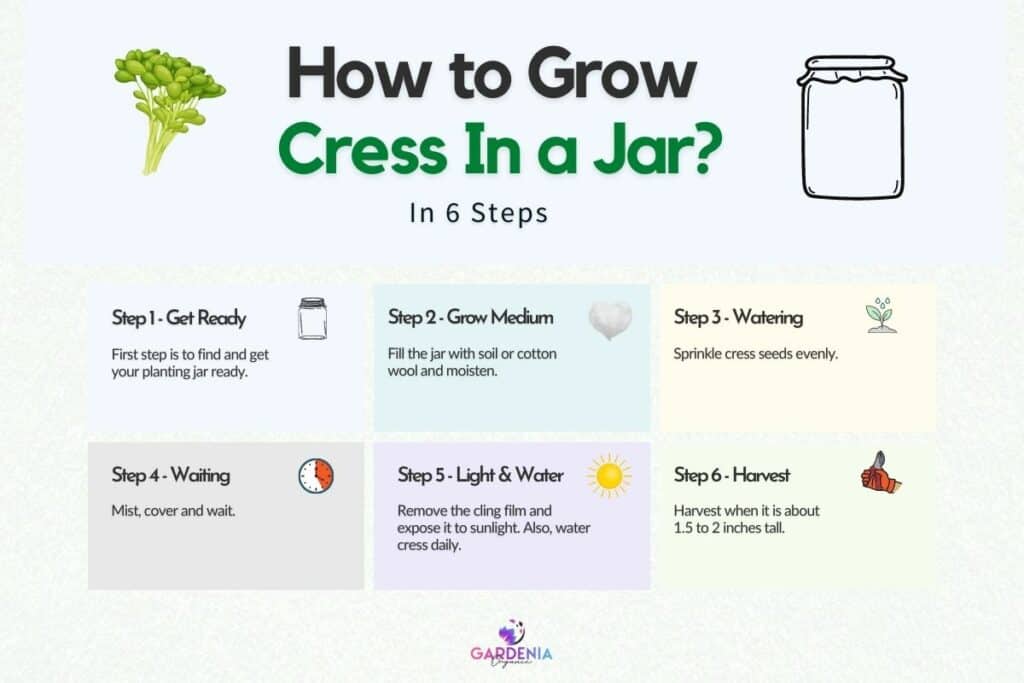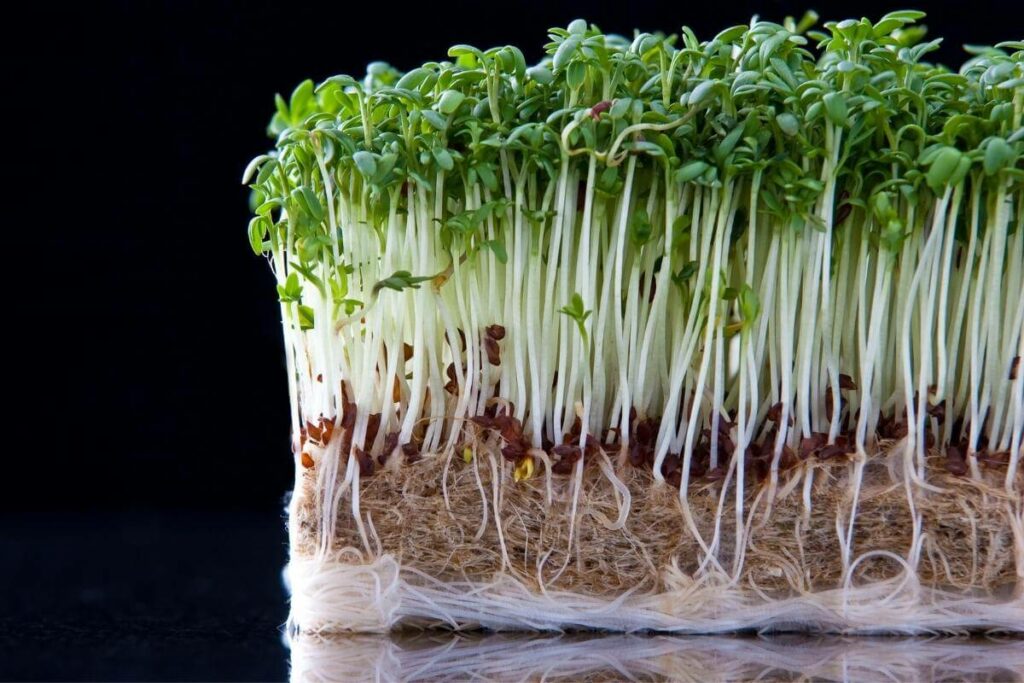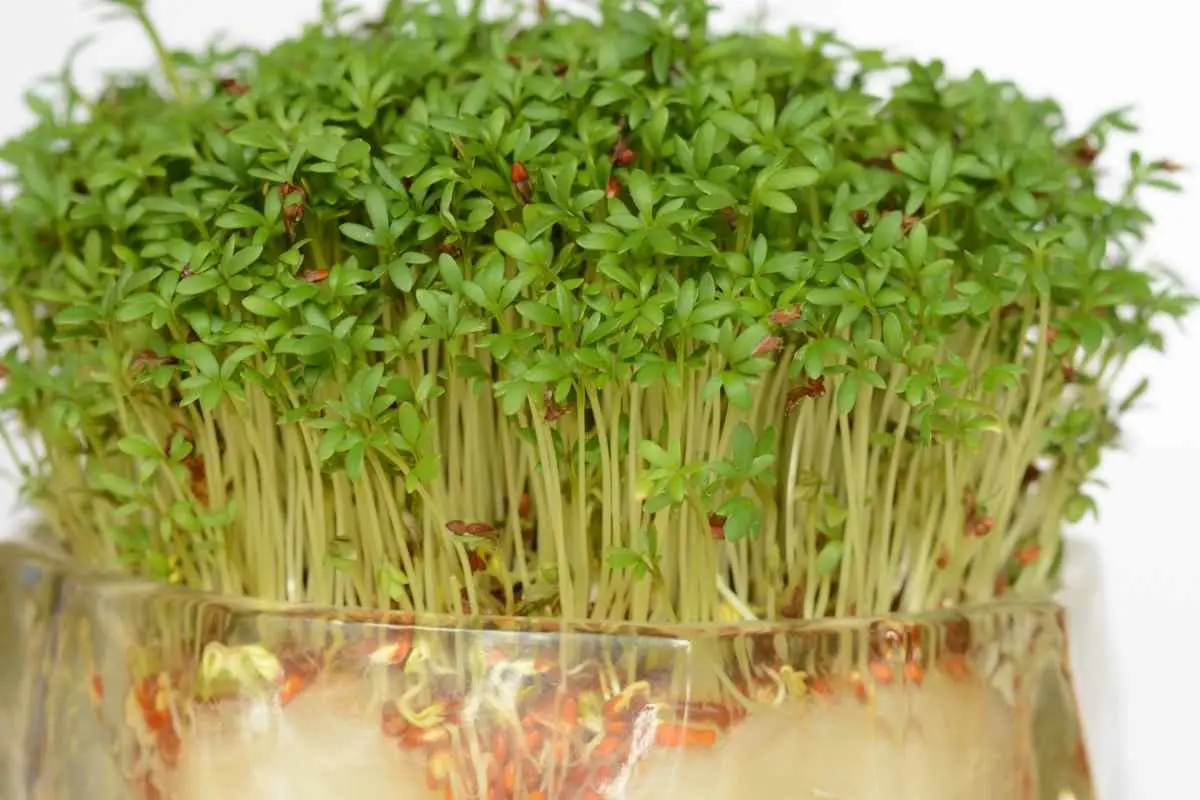Cress is a cool-weather, fast-growing plant, and it’s simple to grow and care for; what’s more, it can be grown indoors in a jar.
A glass Jar is inert; hence it does not release chemicals or react to any growing medium.
It also has a smooth surface, so it doesn’t have any grooves or texture for microorganisms to live in, meaning less mold and disease problems for cress.
To grow cress, one can choose from different cress varieties, such as the Greek, common, or curled cress. No matter the choice, one can be sure that it tastes amazing. And, of course, all varieties are a breeze to grow even indoors in a jar. The plant just needs a growing medium to anchor its roots and take up water to grow. One can use soil, cotton wool, or paper kitchen towels to grow cress seeds in a jar.
Steps In Growing Cress in a Jar
Glass is suitable for growing cress because it’s easy to clean, won’t leech anything or react, is waterproof, and looks great.

To successfully grow garden cress indoors on soil or cotton wool using a jar, follow the step-by-step instructions below:
What you will need:
- Cotton wool or sterile soil
- Cress seeds
- Jar (wider at the top and narrower at the base work best)
- Felt tips for decorating your jar
- Spray bottle
- Cling film
- Scissors
Get Your Planting Jar Ready
Cress should grow quickly in any jar.
However, a shallow jar is recommended instead of a deep one since they don’t grow too tall so a shallow jar will be fine.
Then decorate your jar with the felt tips as you desire.
Filling the Jar
Now that the jar is prepared, you can start filling them with your growing medium.
Fill the container with sterile soil. Alternatively, fluff up some cotton wool and fill the jar with enough cotton wool so that it comes up.
Some people use paper towels, and these works just fine.
Moisten
Use a spray bottle to get your cotton wool or soil nice and moist.
However, be sure it is not entirely soaked that it’s completely drenched in water.
Add Cress Seeds
Sprinkle the cress seeds over the base of the cotton wool or soil.
When sowing the seeds, be sure to spread them out evenly to ensure they are not overcrowded.
It is hard for seeds to germinate and grow roots when there is not enough room for growth.
Press the seeds into the soil or cotton wool.
Mist, Cover, and Wait
Mist the seeds, cover the jar with cling film, and place the jar in a sunny indoor location, such as a windowsill, where it can access enough light to germinate.
These seeds germinate pretty quickly. The seeds will usually germinate within 2-3 days under normal conditions.
Pay Attention: Many factors determine how fast or slow the seeds germinate, such as the temperature, growing environment, and humidity level.
Care for Plants
After the seeds have germinated, make sure to remove the cling film then expose them to sunlight. It would help your cress massively.
This way, they can get enough sunlight to promote their growth, and the leaves can turn green for more nutrients.
Watering Cress
Check on the growth of your seeds daily, and don’t forget to water them.
They don’t require much water, if you have them in direct sunlight on a windowsill, you may want to water them only a little every day.
When watering, make sure you get to the roots.
If you cultivate your cress on cotton wool rather than soil, you will need to apply moisture more often.
Controlling of Pests and Diseases
Cress plants have no serious pest or diseases issues.
They are almost free from all these, especially when grown indoors.
When Is Cress Ready to Harvest and How to Harvest?
When deciding whether to harvest or let it grow some more, you need to check the height and leaves of your cress.
You will know it’s time to harvest cress once it has grown about 1.5 to 2 inches tall. This should take five to ten days after planting.

If the shoots are allowed to develop much further, they will tumble over and begin to fall.
Cress tastes finest when it is in its seed-leaf stage. Please make an effort to cut and consume the cress before it develops.
You can even consume the cress sprouts if you wish.
Harvesting Down Inside a Jar Can Be Tough
The best method is to remove the entire mass from the jar by grabbing all the stems and leaves with one hand, the jar with the other hand.
Then slightly pull the cress up vertically until the whole thing separates without spilling soil everywhere, then trim.
Using scissors or a sharp knife is the simplest technique to harvest cress. Snip the stalks at the base, leaving the roots on the soil or cotton wool.
After That: Give them a rinse, and they should be good to eat! Cress may be kept in the refrigerator for approximately a week if stored properly.
Use of Cress
Cress is becoming increasingly popular in both home kitchens and restaurants.
With its peppery flavor and health-promoting qualities, its hot bite complements sandwiches and salads, soups, and steamed/boiled potatoes. It is also used as a garnish instead of parsley.
Apart from its culinary goodness, cress is especially popular because it’s rich in a wide array of essential nutrients such as:
- enzymes
- antioxidants
- protein
- minerals
Therefore, it can be added to smoothies to increase their nutritional value.
Cress is high in vitamins and minerals, including iron, iodine, phosphorus, and sulfur, all that the body needs.
The end effect is both medical and aesthetic, as the nutrients work as a natural blood purifier, cleaning the skin and providing clarity and shine to the eyes.
When consuming cress, you should always use it when it’s fresh.
Cress Growing on Soil Vs on Cotton Wool in a Jar
Growing them on the soil’s surface is the answer for bigger, healthier, tastier, and more nutritious cress:
- Plants that are grown on soil take up more nutrients and have more value in terms of flavor and yield.
- Cress grown in soil grows at different rates, with some reaching heights much higher than the rest.
On the other hand:
- Cress grown in cotton wool grows uniformly and to roughly the same height.
- Although cress grows well and in a more natural way in the soil, cotton wool is the best material to plant cress in if intended to be eaten since it’s less messy. Since the seeds grow at a more even rate makes it better for easy harvesting.
Final Thoughts
With all benefits and goodness provided by cress, adding cress to your daily diet is the way to go.
You won’t have to purchase it from the grocery store or supermarket every other week since you can easily grow cress plants in your home and have a fresh supply of the veggie at hand every day, and save your coins too!
You May Also Like
- Can You Grow Herbs Indoors Without Sunlight?
- How to Grow Alfalfa Microgreens?
- What to Do with Wheatgrass after Cutting?
